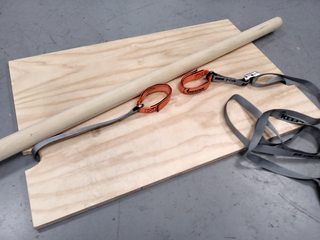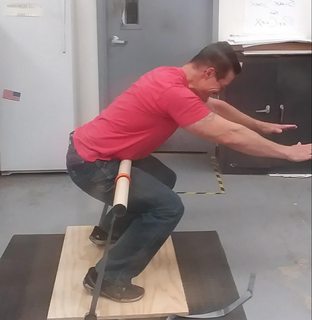North Coast Miller
Level 9 Valued Member
Am a few weeks into a block I intend to run for 3-4 months. Pretty excited about this, so thought I'd share with the crew.
The literature supporting use of Iso-only for mass gain is not very plentiful despite plenty of anecdotal accounts and examples from old time strongmen (who's exact training regimen is largely lost to time). My intention is to use this to gain about 8-10lbs 100% lean mass as well as improve my isotonic lift numbers, will be testing every 4-6 weeks or so.
Have used isometrics before but never in a comprehensive manner and never with intent to do more than rehab or maintain. Through past use I have developed some insight into what I feel is a solid approach, the early results are encouraging. The following is a disgorgement of my thoughts on the topic as well as overview of my current approach (subject to revision!) Also included is pic of the latest training widget that solves a lot of the challenges facing comprehensive use of Isometrics, namely ability to mimic traditional lifts with minimal equipment and ease of change-over.
Generally all my programs are constructed around primary push, pull, hinge, squat with accessory exercises as compliment. In most cases this equals 8 exercises (4 primary, 4 accessory) with a few additional abdominal, bicep, tricep thrown in at the end. I alternate primary and accessory by classification.
This gives every primary lift pattern a break every other session, while maintaining consistent volume to some of the prime moving muscles. This strategy works well with every resistance training mode out there. The selection of specific exercises can be swapped out periodically but should be readily identifiable by classification or otherwise accounted for in the daily volume.
A timer is super helpful!
Day 1
- Zercher Deadlift (primary hinge)
- High Pull/Upright row (accessory pull)
- Quad extension/Hack Squat (accessory squat)
- Benchpress, sandbag for bench (primary push)
- Hammer curls
- Crunches
Day 2
- Squat (primary squat)
- overhead press (accessory push)
- Hamstring extension/curl (accessory hinge)
- Bent Row (primary pull)
- Triceps extension
- Leg raises
Day 3
Jump rope HIIT - 15 minutes
Then repeat Day1 and Day2. I view the HIIT day as optional based on time constraints.
The tool - 2x3' 3/4" plywood with cutouts for strap angle, 4 foot by 2" dowel, 14ft cargo strap with hooks cut off and replaced with webbing tie downs.

Example in use with accessory Quad isolation lunge:

Having the strap cut-outs off center allows me to lean into a lot of my lifts, pre-loading the muscle and providing some initial load feedback.
The literature supporting use of Iso-only for mass gain is not very plentiful despite plenty of anecdotal accounts and examples from old time strongmen (who's exact training regimen is largely lost to time). My intention is to use this to gain about 8-10lbs 100% lean mass as well as improve my isotonic lift numbers, will be testing every 4-6 weeks or so.
Have used isometrics before but never in a comprehensive manner and never with intent to do more than rehab or maintain. Through past use I have developed some insight into what I feel is a solid approach, the early results are encouraging. The following is a disgorgement of my thoughts on the topic as well as overview of my current approach (subject to revision!) Also included is pic of the latest training widget that solves a lot of the challenges facing comprehensive use of Isometrics, namely ability to mimic traditional lifts with minimal equipment and ease of change-over.
My Isometrics Manifesto:
Muscle contraction without changing length.
Overcoming Isometrics - exertion against an immovable resistance
Characterized by
- Reduced muscle glucose utilization
- High % type II muscle fiber activation at >50% effort
- Significant tendon remodeling at >70% effort + > 5 second holds = stiffness nearly 2x
- Analgesic effect on chronic tendon pain and reduction in pain response generally
Longer muscle length increases strength through entire dynamic range - movement dependent! Compound lifts use recruitment patterns that are not uniformly loaded throughout. The shorter the muscle length at exertion, the more specific to that joint angle strength gains will be - reduced strength increase, reduced hypertrophic response
Bracing a muscle group with another of approximate equal strength is contraindicated as it tends toward a balancing act that limits MVC. Use of posture or bracing that relies on bodyweight to anchor contraction effort is likewise contraindicated for same reason. Avoid the "balancing act", it can be tricky to spot with some movements.
Isometrics tend to increase strength more than hypertrophy due to reduced glucose usage and reduced blood occlusion. Glucose metabolism is a driver of anabolism via the Cori Cycle and other metabolic processes. HIIT increases heart rate and preferentially depletes muscle glucose in fast twitch fibers faster than any other exercise strategy. Combining the two should be an effective strategy to improve the adaptive response to isometric stress.
Best Practices I have identified for practical application:
For compound squat, hinge/ lower body movements select a point the ROM that stretches the target muscles and or use a hold from the first (lowest) 1/3 to 1/2 of the lift. For upper body select a hold that stretches the target muscles and pits/braces the hold against a lower body squat or hinge pattern. Generally the bottom 1/3 to 1/2 the ROM. There needs to be a 100% immovable resistance overall, or a winner/loser relationship with the loser being the target muscle group and the winner being used to increase tension during the hold, or even better force a slight eccentric opening of the initial joint angle.
Longer holds can be used, but generally holds using MVC cannot be sustained beyond 12-15 seconds. Holds shorter than 3-5 seconds do not develop max force production. Submaximal efforts should be restricted to rehabilitative and pain management roles, or as an introduction to higher levels of force production. For fitness, in the absence of some external increase in tension, one should do increasing number of repeat efforts if more volume is desired, rather than longer holds. A rest period of about 2:1 or 3:1 is a good starting point.
----------How I use them:
- intent to produce the fastest possible force production. The literature describes best results from a "ballistic effort". I break my holds into 3-4 exhales, the first exhale corresponds with attempt to generate MVC as rapidly as possible, the remaining exhales intent is to ramp up force with every exhale.
- use of stronger muscle groups to overload weaker ones. This cannot really be applied to Squat, DeadLift, Benchpress. For those, tweak the load to floor distance to recruit the best blend of motor units. For upper body holds, set up over a squat or deadlift posture and use them to overload the upper body hold, either to increase tension or to force a bit of eccentric opening of the joint. Eg. overhead press done with a partial knee bend as if finishing off a squat. Press the bar with MVC and then slowly increase tension using leg drive. You will find your ability to exert more force over time increases with an active resistance. Try to replicate that increased effort when training passive resistance holds.
- attempt to "hold" tension on inhale and increase it on exhale- when possible train muscles at longest possible length that still allows good muscle activation to gain better strength increase through the entire ROM. Generally if mimicking traditional lifts, exert at the bottom 1/3 to 1/2 of the ROM.
- use of fast, blood flow encouraging movements between exercise selection such as running in place, jumprope, stationary bike
- 12:36 seconds work to rest. Avoid full blown Valsalva - breath through the movement as though performing isotonic exercise
- 5 "sets" of each exercise with two intervals of max effort jumprope between exercises.
Generally all my programs are constructed around primary push, pull, hinge, squat with accessory exercises as compliment. In most cases this equals 8 exercises (4 primary, 4 accessory) with a few additional abdominal, bicep, tricep thrown in at the end. I alternate primary and accessory by classification.
This gives every primary lift pattern a break every other session, while maintaining consistent volume to some of the prime moving muscles. This strategy works well with every resistance training mode out there. The selection of specific exercises can be swapped out periodically but should be readily identifiable by classification or otherwise accounted for in the daily volume.
A timer is super helpful!
Day 1
- Zercher Deadlift (primary hinge)
- High Pull/Upright row (accessory pull)
- Quad extension/Hack Squat (accessory squat)
- Benchpress, sandbag for bench (primary push)
- Hammer curls
- Crunches
Day 2
- Squat (primary squat)
- overhead press (accessory push)
- Hamstring extension/curl (accessory hinge)
- Bent Row (primary pull)
- Triceps extension
- Leg raises
Day 3
Jump rope HIIT - 15 minutes
Then repeat Day1 and Day2. I view the HIIT day as optional based on time constraints.
The tool - 2x3' 3/4" plywood with cutouts for strap angle, 4 foot by 2" dowel, 14ft cargo strap with hooks cut off and replaced with webbing tie downs.

Example in use with accessory Quad isolation lunge:

Having the strap cut-outs off center allows me to lean into a lot of my lifts, pre-loading the muscle and providing some initial load feedback.
